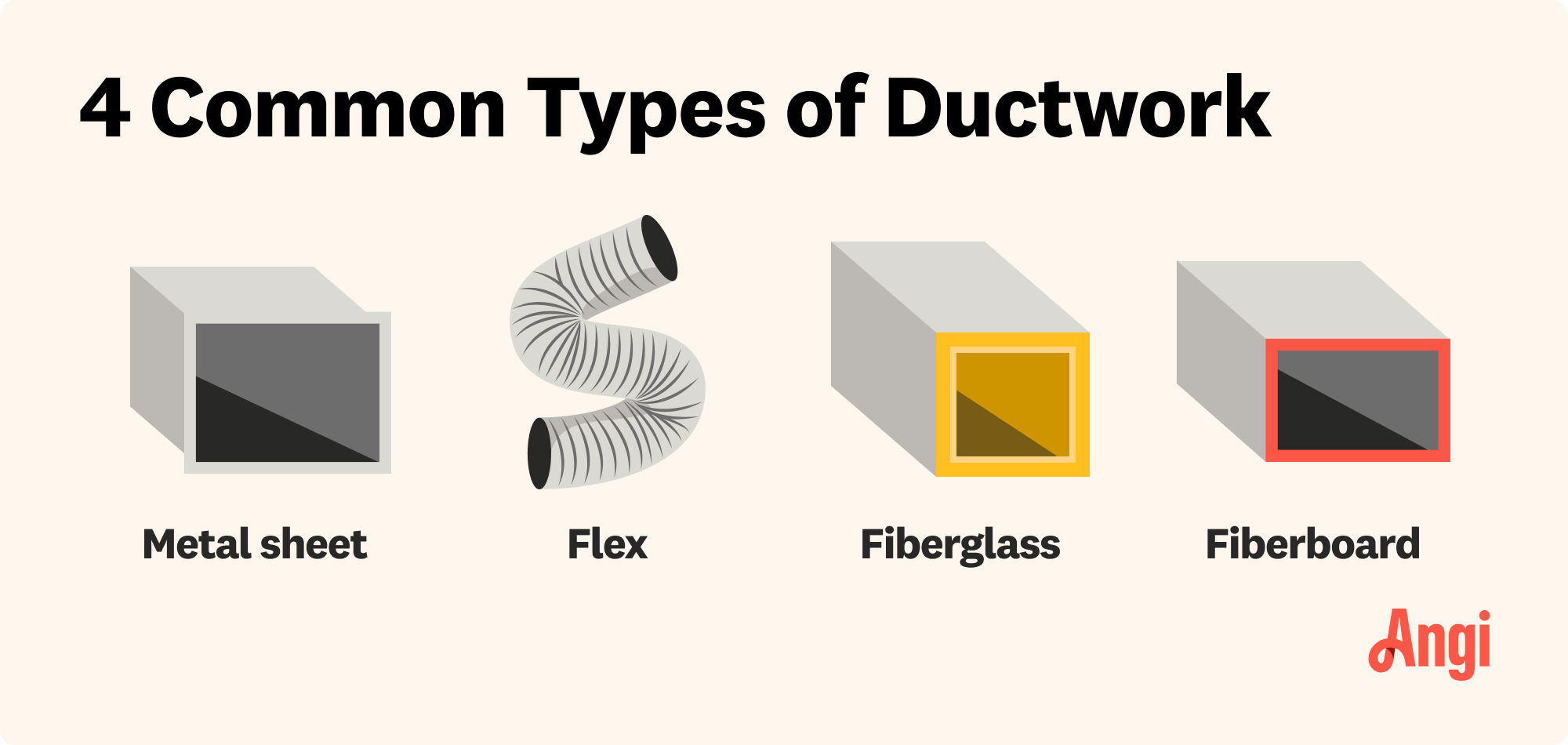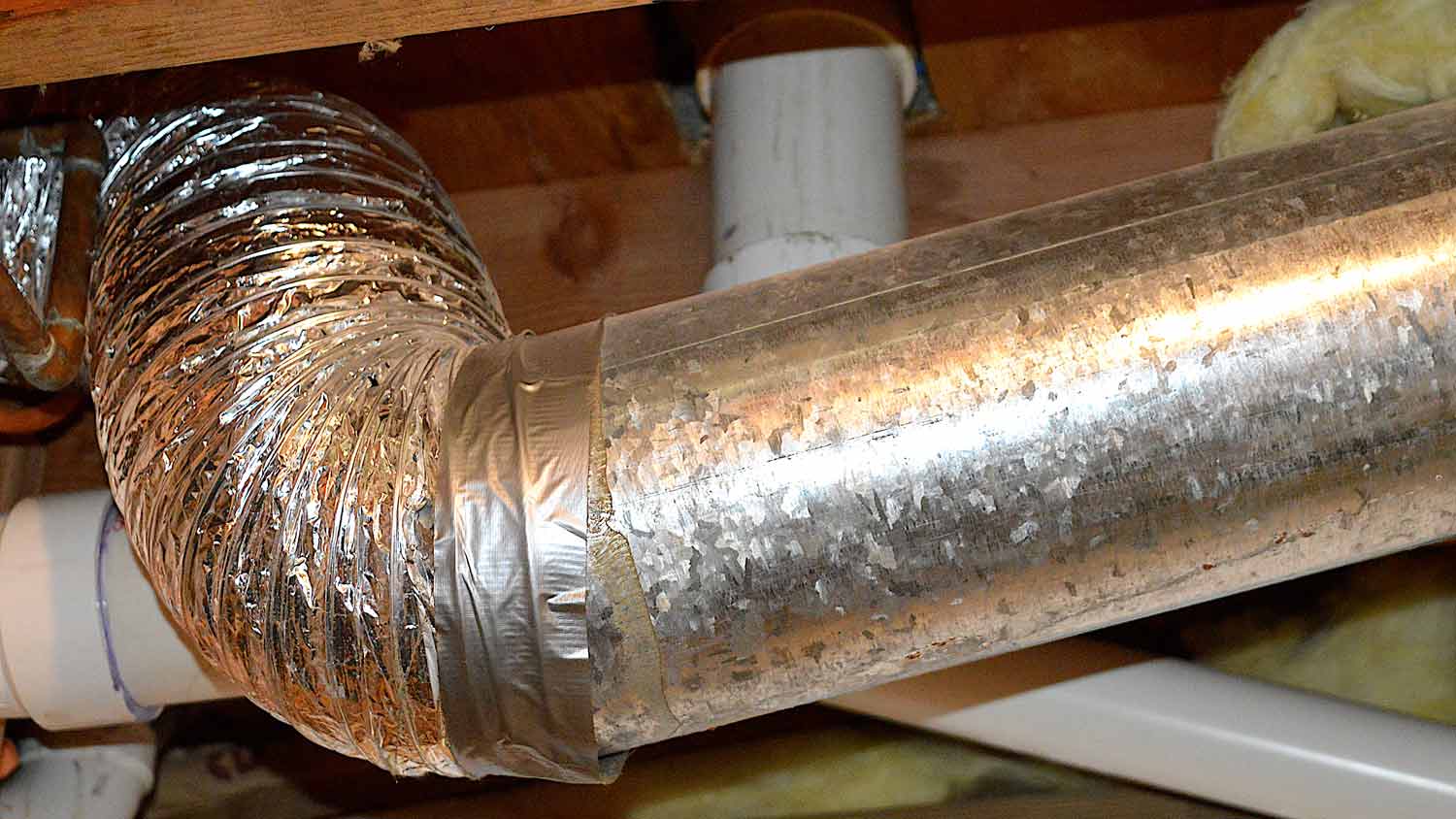
If your furnace is malfunctioning, it could be a faulty control board. Find out what a furnace control board replacement costs for parts, labor, and more.
Get your ducts in a row


Both flexible and rigid ducts distribute air throughout your home.
Flex ducts are less durable but more cost-effective and easier to install.
Rigid ducts are long-lasting but can be trickier to install due to their inflexibility and weight.
You have ductwork to thank for distributing air throughout your home and keeping a comfortable temperature year-round. If you're considering upgrading or installing your home's HVAC system, you need to choose between different types of ductwork: flex or rigid. Learn how these two duct types compare so you can choose the one that works for you.

Flexible ductwork can be made from silicone, rubber, plastic, or plastic-coated fabric, while rigid ducts are made from aluminum or steel. While flexible ducts can change size to fit a particular area, rigid ducts are always the same size and may be shaped like tubes or rectangles.
Other key differences between flex and rigid ducts include their price, ease of installation, and longevity.

Flex ducts are lightweight and tube-shaped with an accordion-like structure that can bend and twist around objects, giving them a lot of versatility on where you can use them. Typically, they have three components: the wire coiling, insulation, and the covering. The covering on a flex duct is commonly made of aluminum but can be made out of a number of materials ranging from plastic, silicone, or fabric.
Flex ducts can come with or without insulation. Insulated flex ducts can regulate heat loss or gain, whereas uninsulated ducts are better for homes in regulated climates where drastic temperatures don’t occur.
| Pros | Cons |
|---|---|
| Lower cost | Require support |
| Easy installation | Shorter longevity |
| Fit into tight spots | Reduced efficiency |
Best for:
Homes with lots of tight areas
Budget-conscious homeowners
One of the biggest benefits of flexible ductwork is its lower cost than rigid ducts. Thanks to their light weight and malleability, they are also much easier to install. You can install flexible ductwork in places that are too small or oddly shaped for rigid ducts.
Flexible ductwork's malleability can sometimes work against it. The ducts require some form of support to prevent sagging. Since they aren't as smooth on the inside as rigid ducts, they may not be as energy efficient.
The biggest drawback to flexible ductwork is that they don't last nearly as long as rigid ducts. Their flexibility can make them more prone to snags and tears.

Rigid ductwork is made from a more structurally sound material but is less forgiving during the installation process. The most common type of rigid duct is galvanized steel (also known as steel ducts), but other materials include aluminum, fiberglass, and fiberboard.
Rigid ducts come in three shapes: rectangular, round, and ovular. In recent years, semi-rigid ducts have come into the market, offering more installation flexibility and cutting down on some of the labor costs.
| Pros | Cons |
|---|---|
| Longevity | Higher cost |
| Greater efficiency | Complicated installation |
| Easy cleaning | Requires precision |
Best for:
Homes in areas that see extremely hot or cold temperatures
Whether made of aluminum or steel, rigid ductwork is built to last. Unlike flexible ducts, it won't snag, tear, or kink. Since the inside of the ducts is completely smooth, air can flow through them more efficiently, leading to lower energy bills. The ducts are also easier to clean compared to flexible options.
The big drawback of rigid ductwork is its price. It costs much more to install rigid ductwork than flexible ducts, and rigid duct replacement costs are also higher due to the complexity of installation.
Rigid ductwork weighs a lot, so it requires more people during installation. A local professional duct installer will also have to cut rigid ductwork to an exact length and ensure that the width of the ducts works in the space.
Here's how flex ducts and rigid ducts stack up.
Rigid ducts win hands down when it comes to durability. Thanks to their sturdy metal material, they resist rust and mold growth and can last for decades.
While rigid ducts win for durability, flexible ducts give them a run for their money. Flex ducts are more affordable, ranging from $1 to $4 per linear foot versus $7 to $13 per linear foot for metal.
Since they have a simpler installation process, the cost to install or replace flexible ducts is also lower than for rigid ducts.
Both rigid and flex ducts can make noise while they work. While the shape of rigid ducts can help them direct sound more smoothly and dampen the hum of airflow, you may hear noise if they become blocked or turn at certain angles.
Flex ducts may also produce noise due to their walls' ability to contract and expand in response to changes in temperature and air pressure. However, flex ducts can also reduce noise if they're made of non-metal materials such as fiberboard or if they're installed at the end of the ductwork system.
All ducts generate noise, but some sounds are cause for concern. A gentle humming or clicking is normal, but loud rattling, banging, buzzing, or whistling means you may have a problem requiring professional help. Some factors that cause excessively noisy ducts include dents or damage, loose metal parts, dirty or blocked vents, and closed dampers.
Once again, flex duct wins for installation ease. The ductwork weighs less, which makes it easier to maneuver. It's also more forgiving in tight areas. Because you can scrunch it, there's more leeway when cutting the ductwork, too.
Rigid ducts are easier to clean than flex ducts, as dirt and debris are less likely to get trapped inside them. Since they resist rust and mold growth, you don't have to worry as much about cutting the ductwork in place to replace sections of it.
Flex ducts require more frequent cleanings than rigid ducts, to keep dust and debris from collecting inside.
Thanks to the smooth interior surface, air flows easily through rigid ducts, which can help your HVAC heat or cool your home more efficiently. While flex ducts can still heat and cool your home, they do so with slightly less efficiency, thanks to the uneven texture inside.
The cost to replace air ducts ranges from $455 to $2,185, with the average person paying $1,250. If you’re starting your duct framework from scratch, costs depend heavily on the type and installation method. The cheapest option is exposed ductwork, which costs between $1,600 and $4,800 or an average of $2,200.
The price you pay will depend on your home’s size, the condition of your interior walls, which types of ducts you choose, and any repairs needed.
While it may save you some money, installing air ducts yourself isn’t recommended unless you’re an extremely skilled DIYer. The labor costs associated with this project can range anywhere from $2,000 to $5,000, depending on the professional and the job scope. However, a lot can go wrong if you install air ducts yourself improperly, such as leaks, HVAC damage, poor energy efficiency, and insurance issues. Ultimately, it’s not worth the price of your time or the risk to do it yourself, so hire a local air duct professional for the job.
Nathaniel and Austin did a really great job. They were very professional and were careful with our furniture.
I recently hired American Arborist for a large tree removal project, and I couldn’t be more impressed with the entire experience. From the first phone call to the final cleanup, their team was professional, efficient, and incredibly knowledgeable. We had a towering oak that was not only...
This man charged me $650 to juice up my air conditioner. He told me it had a leak, but could make it work for the next year, and I could look into getting it replaced next year. After spending all that money out still didn't work. I asked for $200 back, and he said he can't, even...
Robert also provides my lawn care. He pays attention to detail, is a pleasure to work with. I am so happy with the patio he built and the lawn care he provides. Very trust worthy and fabulous!
On time very efficient. I feel safe and secure now.
Very polite and punctual. Kept me informed of costs before he did the work. Charged me what he said he would and advised me on future needs. Very professional!
Reliable, Affordable and fast service. Job well done
Perfect service. Fast and courteous. Very effective.
Mr. Bylers did our cabinets and island for a large kitchen remodel about 7 years ago. The quality is top notch. Mr. Byler is a consummate professional and amazing cabinet maker. You will not be disappointed! Very highly recommend. We downsized this year and the hardest part was leaving the...
Absolutely the best! Super professional pays attention to the tiniest details and doesnt miss anything
From average costs to expert advice, get all the answers you need to get your job done.

If your furnace is malfunctioning, it could be a faulty control board. Find out what a furnace control board replacement costs for parts, labor, and more.

A faulty evaporator coil is a common cause of AC failure. But how much does an evaporator coil replacement cost? We explore the factors here.

Exposed ductwork can be a smart choice even beyond aesthetics. Fortunately, exposed ductwork costs are relatively low, and easy access keeps repair costs to a minimum.

Knowing when to replace your boiler will help you avoid last-minute emergencies in the middle of winter. Here are seven signs that you may need a brand-new unit.

Save energy and prolong the life of your heating pump with proper maintenance and preventative care. An annual service will keep things running smoothly.

No one likes a cold shower or a frigid winter night. Regular boiler maintenance and repair will ensure your appliance stays in tip-top shape. Keep the hot water flowing year-round with these easy tips.